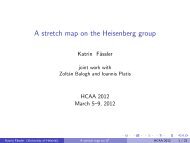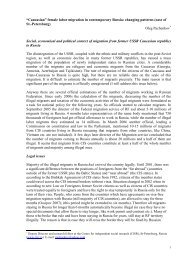THORIUM AS AN ENERGY SOURCE - Opportunities for Norway ...
THORIUM AS AN ENERGY SOURCE - Opportunities for Norway ...
THORIUM AS AN ENERGY SOURCE - Opportunities for Norway ...
You also want an ePaper? Increase the reach of your titles
YUMPU automatically turns print PDFs into web optimized ePapers that Google loves.
5.3.1 Light Water Reactor (LWR)<br />
Nuclear Reactors <strong>for</strong> Thorium<br />
The Light Water Reactors (LWRs) utilize fuel based on uranium dioxide (UO2), plutonium dioxide<br />
(PuO2) and/or thorium dioxide (ThO2) arranged in fuel rods. In the development of thoriumuranium<br />
oxide fuels in LWRs, two types of arrangements have been explored:<br />
1. Homogeneous mixed oxides of thorium and highly enriched uranium in uni<strong>for</strong>m lattices (the<br />
BORAX-IV, Indian Point I PWR, and Elk River BWR reactors).<br />
2. Heterogeneous arrangements where the blanket contains less uranium and is responsible <strong>for</strong><br />
most of the in-core fissile generation (Shippingport PWR).<br />
In the Shippingport Light Water Breeder Reactor (LWBR) program, the feasibility of net breeding<br />
of fissile isotopes in the core was investigated. The results confirmed that the ratio of the fissile<br />
content of the fuel at the end of operation to that at the beginning of operation was about 1.0139.<br />
The ef<strong>for</strong>t also identified some shortcomings of the LWBR technology relative to the LWR<br />
experience at that time, including a lower power density of the core (30 %), a need <strong>for</strong> high U-235<br />
enrichments in the early stage of deployment, a more complicated design of a movable seed region<br />
as well as a more complicated recycling of uranium and thorium including extra shielding needed<br />
in the fabrication process compared to uranium and Pu recycling [45].<br />
The main conclusions of the EPRI sponsored study on thorium cycle applications in the<br />
Combustion Engineering System 80 PWRs can be summarized as follows:<br />
• Use of thorium with recycling 3 can in the long run increase energy output per mined tonne of<br />
uranium by about 85 % beyond the once-through 4 uranium cycle, and by 22 % beyond<br />
plutonium recycle.<br />
• Even with the above, the thorium cycle may not be economically attractive relative to cycles<br />
with poor fuel conservation features because the early years' fuel demand is high, and savings<br />
occur in later years.<br />
• Comparison of the characteristics of uranium and thorium based cores indicates that thorium<br />
fuelling is feasible, and modifications to a PWR designed to accommodate plutonium recycle do<br />
not appear to be required.<br />
• The introduction of a totally new system of advanced converters into the US would probably<br />
require more ef<strong>for</strong>t and funding than can be justified.<br />
In past attempts to improve LWR fuel cycle efficiency, it has been recognized [46], [47] that the<br />
advanced converter concepts attain superior fuel utilization by elimination of major parasitic<br />
reactivity control through one of three methods: adoption of on-line re-fuelling (C<strong>AN</strong>DU, Molten<br />
Salt and Pebble Bed), special geometry to capture leakage neutrons (seed-blanket), or moderation<br />
control of neutron capture in fertile material (spectrum shift). At this stage only the C<strong>AN</strong>DU<br />
reactor has been successfully deployed worldwide. All these cores can have improved fuel<br />
efficiencies when recycling the fissile material as well as with introduction of thorium in addition<br />
to uranium in the fuel.<br />
5.3.2 High Temperature Gas Cooled Reactor (HTGR)<br />
KFA Jülich, Germany, has four decades of experience with thorium and its use as a nuclear fuel.<br />
Thorium fuel with coated fuel particles (about 100 000) has been successfully tested in two High<br />
3<br />
Closed Fuel Cycle (the fuel is recycled): Reprocessing of spent fuel to extract the remining fissile material <strong>for</strong> further use.<br />
4<br />
Open Fuel Cycle (once-through cycle): The fuel is wasted after use (some fissile material left).<br />
43

















